Telescope Reviews
Page 17
By Ed Ting
Updated 8/5/04
Click on a Telescope Below:
1) Discovery 12.5" Truss Dobsonian
2) Obsession 18" Dobsonian
3) Starmaster 14.5" Dobsonian
1) Discovery 12.5" Truss Dob 7/16/01
(12.5" f/5 open truss Dobsonian reflector, $1999, some options available)
Discovery telescopes have been around for a while, but you may not have been
aware of them. Originally serving as an OEM (original equipment manufacturer)
for other brands (if you've looked through an older Celestron Starhopper or
Orion DSE, you've looked through a Discovery) the company has now branched
out on its own.
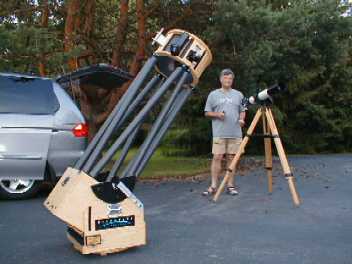 The 12.5" Discovery Dob (TeleVue
Genesis in background) The "Smallest
of the Big Scopes?"
Discovery has three models (12.5", 15", 17") in its open truss lineup, serving as
lower cost alternatives to the price-no-object Dobs from outfits like Obsession,
Starmaster, Portaball, etc. And the 12.5" model is a very fine one indeed.
The mirror threw up an excellent star test, with only mild undercorrection at
200X. The motions are smooth, although the axes require just a little more
effort than the buttery-smooth Obsession and Starmaster units. The wrap-around
light shroud is well-made, and closes along its length with velcro. The wood
working is nicely done - a nice little bonus I wasn't expecting at this price level.
Pete Smitka (of Portaball fame) once told me that an 8" telescope is the "biggest
of the small scopes," while a 12.5" is the "smallest of the big scopes." Eight and
twelve inches also happen to be almost exactly one magnitude apart. This may
help explain the popularity of these apertures. A 12.5" Newtonian will go deep
enough to satisfy the deep sky crowd, but it's still portable enough that you'll
use it.
The 12.5" Discovery Dob (TeleVue
Genesis in background) The "Smallest
of the Big Scopes?"
Discovery has three models (12.5", 15", 17") in its open truss lineup, serving as
lower cost alternatives to the price-no-object Dobs from outfits like Obsession,
Starmaster, Portaball, etc. And the 12.5" model is a very fine one indeed.
The mirror threw up an excellent star test, with only mild undercorrection at
200X. The motions are smooth, although the axes require just a little more
effort than the buttery-smooth Obsession and Starmaster units. The wrap-around
light shroud is well-made, and closes along its length with velcro. The wood
working is nicely done - a nice little bonus I wasn't expecting at this price level.
Pete Smitka (of Portaball fame) once told me that an 8" telescope is the "biggest
of the small scopes," while a 12.5" is the "smallest of the big scopes." Eight and
twelve inches also happen to be almost exactly one magnitude apart. This may
help explain the popularity of these apertures. A 12.5" Newtonian will go deep
enough to satisfy the deep sky crowd, but it's still portable enough that you'll
use it.
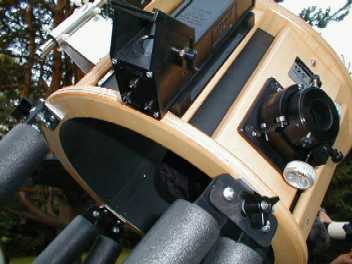 Closeup of the Upper Truss Assembly
Note the clean woodworking
Discovery has always specialized in innovative little human touches, and the 12.5"
is no exception. The dust cover clips onto the rear carrying handle when not in
use, which means it won't roll away on you, or stay on the ground waiting for
someone to step on it. The secondary holder has flattened thumb collimation
screws, so you can collimate the scope without any tools - nice (the assembly
hardware is not captive, however.) Finally, Discovery seems to have gone through
pains to make sure the scope is as compact as possible - my 10" f/6 Starmaster
EL is slightly larger than this 12.5".
The owner of this Discovery wound up putting extra handles on the side of the
rocker box, added a neat counterweight system to the rear of the box, and
placed little light-blocking pieces of cardboard to cover up the spaces where
the shroud doesn't completely cover. Also, he slotted the truss poles with
a saw to make insertion easier, and gasketed the hardware.
Closeup of the Upper Truss Assembly
Note the clean woodworking
Discovery has always specialized in innovative little human touches, and the 12.5"
is no exception. The dust cover clips onto the rear carrying handle when not in
use, which means it won't roll away on you, or stay on the ground waiting for
someone to step on it. The secondary holder has flattened thumb collimation
screws, so you can collimate the scope without any tools - nice (the assembly
hardware is not captive, however.) Finally, Discovery seems to have gone through
pains to make sure the scope is as compact as possible - my 10" f/6 Starmaster
EL is slightly larger than this 12.5".
The owner of this Discovery wound up putting extra handles on the side of the
rocker box, added a neat counterweight system to the rear of the box, and
placed little light-blocking pieces of cardboard to cover up the spaces where
the shroud doesn't completely cover. Also, he slotted the truss poles with
a saw to make insertion easier, and gasketed the hardware.
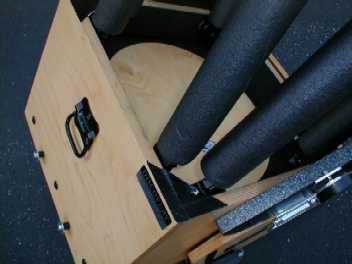 Closeup on the mirror box
I spent a long evening with this telescope. Also present were the Meade 178ED,
152ED, TeleVue Genesis, and the 10" AP Mak. Despite all the expensive glass
lying around, the Discovery seemed just as popular with the observers as the
high-zoot stuff nearby. We caught the mid summer Messier objects, a few
doubles, and Mars, which was just past opposition. The double-double was
split easily into four little round balls despite only so-so seeing conditions.
The 14.2 magnitude star near the Ring was readily visible, and the Dumbbell
begins to take on that familiar shape that you're used to seeing in photographs.
Also, at the 10"-12" level, globulars start taking on individual personalities,
instead of looking like the same grainy blobs.
A second evening under dark, transparent skies reinforced my positive impressions
of this scope. With an O-III filter, you can pick out some impressive detail in
the Veil. The spiral arms of M51 are easily visible. The optics are good enough
that you can push 300X or higher and still retain sharpness on globulars like
M13, M3, and M92. Tracking is smooth and trouble-free up to about 175X or
so; above that level you start working a bit to keep the motions smooth.
Some of you may be wondering what you may be missing by buying one of these
instead of an Obsession, Starsplitter, Starmaster, etc. The answer is, for many
of you, not much. I'd guess a scope of this quality might satisfy a good 80%
of observers out there, who would buy one and never look back. A Starmaster,
Starsplitter, Portaball, or Teleport can be ordered with a stunning Zambuto
mirror. The woodworking and attention to detail on an Obsession are a couple
of steps beyond this Discovery. All of the luxo-Dobs have slightly smoother
motions, which allows for more accurate hand-tracking at higher powers. And
buying one of the high-zoot Dobs immediately puts you into an elite, exclusive
crowd. But not everyone can afford to pay (and wait) for a Zambuto mirror, or
a made-to-order Obsession. And some don't care about image. If you're in the
latter category, the Discovery might be the choice for you, and I'm guessing
you would be very happy with one. Me, I'm glad these guys are around. They
fill a niche that's been open for too long. Go, Discovery!
Discovery 12.5" Hots
Closeup on the mirror box
I spent a long evening with this telescope. Also present were the Meade 178ED,
152ED, TeleVue Genesis, and the 10" AP Mak. Despite all the expensive glass
lying around, the Discovery seemed just as popular with the observers as the
high-zoot stuff nearby. We caught the mid summer Messier objects, a few
doubles, and Mars, which was just past opposition. The double-double was
split easily into four little round balls despite only so-so seeing conditions.
The 14.2 magnitude star near the Ring was readily visible, and the Dumbbell
begins to take on that familiar shape that you're used to seeing in photographs.
Also, at the 10"-12" level, globulars start taking on individual personalities,
instead of looking like the same grainy blobs.
A second evening under dark, transparent skies reinforced my positive impressions
of this scope. With an O-III filter, you can pick out some impressive detail in
the Veil. The spiral arms of M51 are easily visible. The optics are good enough
that you can push 300X or higher and still retain sharpness on globulars like
M13, M3, and M92. Tracking is smooth and trouble-free up to about 175X or
so; above that level you start working a bit to keep the motions smooth.
Some of you may be wondering what you may be missing by buying one of these
instead of an Obsession, Starsplitter, Starmaster, etc. The answer is, for many
of you, not much. I'd guess a scope of this quality might satisfy a good 80%
of observers out there, who would buy one and never look back. A Starmaster,
Starsplitter, Portaball, or Teleport can be ordered with a stunning Zambuto
mirror. The woodworking and attention to detail on an Obsession are a couple
of steps beyond this Discovery. All of the luxo-Dobs have slightly smoother
motions, which allows for more accurate hand-tracking at higher powers. And
buying one of the high-zoot Dobs immediately puts you into an elite, exclusive
crowd. But not everyone can afford to pay (and wait) for a Zambuto mirror, or
a made-to-order Obsession. And some don't care about image. If you're in the
latter category, the Discovery might be the choice for you, and I'm guessing
you would be very happy with one. Me, I'm glad these guys are around. They
fill a niche that's been open for too long. Go, Discovery!
Discovery 12.5" Hots
Very good optics
Compact, stylish mechanical assembly
Reasonable price
Nice ergonomic touches
Discovery 12.5" Nots
Minor mechanical modifications may be necessary to suit your personal tastes
and habits
Axis motions slightly stiff
No fancy brand name to stroke your ego
Verdict
A solidly designed and well made telescope. Confidently recommended.
2) 18" Obsession 7/30/01, 8/3/01, 8/4/04
(18" f/4.5 Dobsonian Newtonian, $4295, add $139 for shroud, $45 for Telrad)
(Note: Price is now $5295 as of 8/04)
(Note: see also review of the 20" Obsession)
The 18" is one of the most popular models in Dave Kriege's fine line of
Obsession telescopes. With a shorter f/ ratio (f/4.5 vs f/5) and a slightly
smaller mirror, it winds up being much smaller than the 20". Having used
the 20" for about two years now, I was taken aback by how much more
compact the 18" is (although the photo below doesn't really show this very
well.)
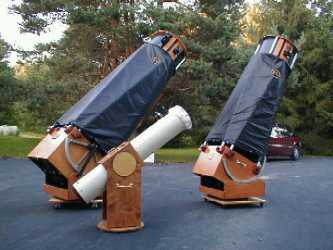 20" (L) and 18" (R) Obsessions
6" Dob in front for scale
Having gone into detail already on the review of the 20" (review), I won't
belabor the point here. This is a marvelous telescope and you're going
to have a ball with it if you're not used to anything this large. You need
a small stepstool to get to the eyepiece at the zenith, vs. a full-sized
5 foot ladder for the 20". The shorter truss poles and more compact mirror
box makes the 18" (and the 15" for that matter) incredibly rigid and taut,
given the unit's size. Tracking is buttery-smooth, even at 250X+. The
secondary can now be collimated without tools, a nice improvement over
the old system. Cool down, from a hot summer sun-drenched garage to a
cool 60 degree summer night, takes about 45-60 minutes (faster if you run
the fan.)
Dave Kriege jumps through hoops to make his telescopes as compact and
light as possible. The weight on this unit is only 105 lbs or so, which you
never lift - wheelbarrow handles bolt into the side of the mirror box, allowing
you to move the scope easily (Obsession says the weight at the handles is 18
lbs.) The telescope looks impressively large and imposing while assembled,
but when you break it down (a 7-10 minute operation) you would barely notice
it's there. A telescope is mostly air, when you think about it. I've seen people
fit two in their minivans.
Quality woodworking is the calling card of any Dave Kriege telescope, and this
one is no exception. The choice of parts, selection of woods, and attention
to detail are second to none (and I say this as a die-hard Starmaster fan.)
As mentioned before, the Obsessions are the most compact of the premium
Dobsonians. As an example, most other manufacturers attach their truss poles
on the inside of the rocker boxes, which makes for larger rocker boxes. Ob-
session's truss poles (like Starsplitter's) attach to the outside, which allows the
designer to shrink the size of the rocker box. It's barely larger than the mirror
(see photo below.) As a result of design decisions like these, an Obsession
is often a full frame size smaller, per given aperture level, than other similar
telescopes. It's the one to get if portability is a big issue.
20" (L) and 18" (R) Obsessions
6" Dob in front for scale
Having gone into detail already on the review of the 20" (review), I won't
belabor the point here. This is a marvelous telescope and you're going
to have a ball with it if you're not used to anything this large. You need
a small stepstool to get to the eyepiece at the zenith, vs. a full-sized
5 foot ladder for the 20". The shorter truss poles and more compact mirror
box makes the 18" (and the 15" for that matter) incredibly rigid and taut,
given the unit's size. Tracking is buttery-smooth, even at 250X+. The
secondary can now be collimated without tools, a nice improvement over
the old system. Cool down, from a hot summer sun-drenched garage to a
cool 60 degree summer night, takes about 45-60 minutes (faster if you run
the fan.)
Dave Kriege jumps through hoops to make his telescopes as compact and
light as possible. The weight on this unit is only 105 lbs or so, which you
never lift - wheelbarrow handles bolt into the side of the mirror box, allowing
you to move the scope easily (Obsession says the weight at the handles is 18
lbs.) The telescope looks impressively large and imposing while assembled,
but when you break it down (a 7-10 minute operation) you would barely notice
it's there. A telescope is mostly air, when you think about it. I've seen people
fit two in their minivans.
Quality woodworking is the calling card of any Dave Kriege telescope, and this
one is no exception. The choice of parts, selection of woods, and attention
to detail are second to none (and I say this as a die-hard Starmaster fan.)
As mentioned before, the Obsessions are the most compact of the premium
Dobsonians. As an example, most other manufacturers attach their truss poles
on the inside of the rocker boxes, which makes for larger rocker boxes. Ob-
session's truss poles (like Starsplitter's) attach to the outside, which allows the
designer to shrink the size of the rocker box. It's barely larger than the mirror
(see photo below.) As a result of design decisions like these, an Obsession
is often a full frame size smaller, per given aperture level, than other similar
telescopes. It's the one to get if portability is a big issue.
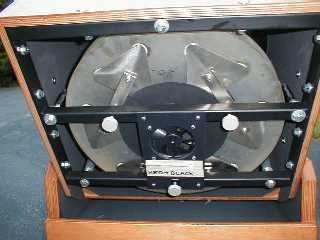 A telescope is mostly air - photo
of the mirror cell, with cooling fan
This sample was bought by a club member who had seen the 20" and its
review last year (I am such a bad influence...) He ordered it with a Torus
mirror (Nova is standard) and paid $300 for the enhanced coatings. The mirror's
correction is excellent - I detected only very slight overcorrection at 200X.
This is impressive for such a large mirror. The surface figure looks very
smooth as well. While looking at M13, the Ring, M71, etc., stars focus
down to tiny pinpoints under good conditions. The color contrast on Albireo
is immediately obvious.
I had to 20" and the 18" together one night and decided to test the old
saw that there isn't much difference at a certain aperture level under light
polluted conditions. Pointing both telescopes at a light-polluted area of
the southern sky, the 20" did, in fact, still go deeper - noticeably. Tele-
scopes gather light indiscriminately - light pollution and skyglow get sent
up to the eyepiece right alongside your favorite deep sky object. So while
the 20" goes deeper, the view is browner, and the sky background brighter,
than the 18". How much this means to you depends on the individual. Several
years ago, I would have found this intolerable. Now, I don't mind so much,
and welcome the light grasp of a larger scope. Under dark skies, of course,
it's all over - in good conditions, larger scopes always win on deep sky
objects.
Having been a small-scope kind of guy for decades, I am slowly gravitating
towards large-aperture telescopes again. I find I can use the 20" under most
reasonable nights, and keeping the scope fully assembled on a rolling platform/
cart lets me deploy it within a couple of minutes. I can actually set up the
20" about as quickly as I can set up a 6" Dobsonian. Hey, if I can have 20",
why settle for six?
A telescope is mostly air - photo
of the mirror cell, with cooling fan
This sample was bought by a club member who had seen the 20" and its
review last year (I am such a bad influence...) He ordered it with a Torus
mirror (Nova is standard) and paid $300 for the enhanced coatings. The mirror's
correction is excellent - I detected only very slight overcorrection at 200X.
This is impressive for such a large mirror. The surface figure looks very
smooth as well. While looking at M13, the Ring, M71, etc., stars focus
down to tiny pinpoints under good conditions. The color contrast on Albireo
is immediately obvious.
I had to 20" and the 18" together one night and decided to test the old
saw that there isn't much difference at a certain aperture level under light
polluted conditions. Pointing both telescopes at a light-polluted area of
the southern sky, the 20" did, in fact, still go deeper - noticeably. Tele-
scopes gather light indiscriminately - light pollution and skyglow get sent
up to the eyepiece right alongside your favorite deep sky object. So while
the 20" goes deeper, the view is browner, and the sky background brighter,
than the 18". How much this means to you depends on the individual. Several
years ago, I would have found this intolerable. Now, I don't mind so much,
and welcome the light grasp of a larger scope. Under dark skies, of course,
it's all over - in good conditions, larger scopes always win on deep sky
objects.
Having been a small-scope kind of guy for decades, I am slowly gravitating
towards large-aperture telescopes again. I find I can use the 20" under most
reasonable nights, and keeping the scope fully assembled on a rolling platform/
cart lets me deploy it within a couple of minutes. I can actually set up the
20" about as quickly as I can set up a 6" Dobsonian. Hey, if I can have 20",
why settle for six?
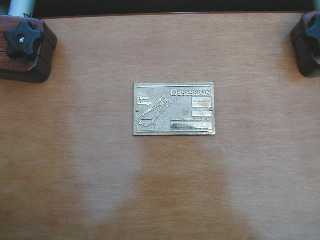 Each Obsession owner gets their name
engraved on a numbered brass plaque
on the mirror box - nice touch
Unfortunately, like nearly any telescope worth owning these days, Obsessions
have a long lead time. Expect a 9 month wait for one, although you can usually
speed this up if you order a premium mirror like a Torus or a Pegasus (yes, you
pay more -a LOT more in some cases- but the option is there if you need it.)
Don't forget to order the "optional" shroud and the Telrad ($45).
A telescope like this 18" Obsession is going to be a revelation for anyone used
to looking through a 6" Newtonian or an 8" Schmidt-Cassegrain. Even people
accustomed to 10"-12.5" apertures are often amazed when they get a hold of a
telescope of this size. In fact, there seems to be a threshold, somewhere in
this 18"-20" range, where you start getting the feeling that you can do just
about anything, given good enough conditions. You start looking at those tiny
galaxies and planetaries plotted in your star atlas and seeing them as easy
prey. Looking at the level of detail in the Veil with an O-III filter knocks my
socks off every fall. I never get tired of looking at it.
The optics are of very high quality, the woodworking is top-notch, and the sheer
aperture gain is going to be an eye-opener for the small-scope folks out there.
Like all the Obsessions, this one gets the highest recommendation.
Update, 8/3/01: Dave Kriege reports that he has recently purchased about 100
Torus mirrors of various sizes. Torus mirrors cost more than the standard Nova
units (about $250 to $500 extra), but as of this writing, he is prepared to deliver
most Obsession models within 30 days of placement of an order. It's a temporary
boon for those who have aperture fever but don't want to wait for their scopes.
3) Starmaster 14.5" Dobsonian 9/5/01
(14.5" f/4.3 Newtonian, $3995 + options)
Suddenly, it's Big Dob Season here at Scopereviews.
I first met Rick Singmaster several years ago at Astrofest. It is interesting to
see the differences between Obsession and Starmaster, as they usually set up
across the aisle from each other. Dave Kriege is a gentle giant. Rick Singmaster
looks as if he had just walked off the set of an old movie western (every time I
see him I want to call him "Sheriff.")
Each Obsession owner gets their name
engraved on a numbered brass plaque
on the mirror box - nice touch
Unfortunately, like nearly any telescope worth owning these days, Obsessions
have a long lead time. Expect a 9 month wait for one, although you can usually
speed this up if you order a premium mirror like a Torus or a Pegasus (yes, you
pay more -a LOT more in some cases- but the option is there if you need it.)
Don't forget to order the "optional" shroud and the Telrad ($45).
A telescope like this 18" Obsession is going to be a revelation for anyone used
to looking through a 6" Newtonian or an 8" Schmidt-Cassegrain. Even people
accustomed to 10"-12.5" apertures are often amazed when they get a hold of a
telescope of this size. In fact, there seems to be a threshold, somewhere in
this 18"-20" range, where you start getting the feeling that you can do just
about anything, given good enough conditions. You start looking at those tiny
galaxies and planetaries plotted in your star atlas and seeing them as easy
prey. Looking at the level of detail in the Veil with an O-III filter knocks my
socks off every fall. I never get tired of looking at it.
The optics are of very high quality, the woodworking is top-notch, and the sheer
aperture gain is going to be an eye-opener for the small-scope folks out there.
Like all the Obsessions, this one gets the highest recommendation.
Update, 8/3/01: Dave Kriege reports that he has recently purchased about 100
Torus mirrors of various sizes. Torus mirrors cost more than the standard Nova
units (about $250 to $500 extra), but as of this writing, he is prepared to deliver
most Obsession models within 30 days of placement of an order. It's a temporary
boon for those who have aperture fever but don't want to wait for their scopes.
3) Starmaster 14.5" Dobsonian 9/5/01
(14.5" f/4.3 Newtonian, $3995 + options)
Suddenly, it's Big Dob Season here at Scopereviews.
I first met Rick Singmaster several years ago at Astrofest. It is interesting to
see the differences between Obsession and Starmaster, as they usually set up
across the aisle from each other. Dave Kriege is a gentle giant. Rick Singmaster
looks as if he had just walked off the set of an old movie western (every time I
see him I want to call him "Sheriff.")
 Nice scope, Sheriff...
Anyway, through the course of that weekend, I kept wandering over to the demos
of the EL telescopes, which had just been introduced at the time. I unwittingly
sold several of these for Starmaster just by showing people the views. The
intelligence of design, wonderful woodworking, and stunning Zambuto mirrors
have made the ELs (now ELTs) the choice for discriminating mid-aperture Dob
lovers. At the end of the weekend, I was still playing with Rick's demo as he
packed up his van. "Aw Hell, Ed," he said. "I suspect you oughtta get yourself
one of those." I suspect he was right. And I did. And I suspect I have been
very happy ever since.
The 14.5" is the smallest member of Starmaster's "standard" (ie non EL/ELT) line.
This same basic mechanical design goes all the way up the 22"-24" range. As such,
the 14.5" is unusually rigid and tight for a scope this size. The truss poles come
asssembled in "A" frames that bolt to the mirror box. Four long bolts secure the
upper truss to the rocker box, just like the EL/ELTs. The mirror cell assembly
actually comes out, and Starmaster provides a separate wooden case for transporting
your valuable Zambuto mirror. One source tells me that with careful packing, one
of these will fit inside a Dodge Neon.
Nice scope, Sheriff...
Anyway, through the course of that weekend, I kept wandering over to the demos
of the EL telescopes, which had just been introduced at the time. I unwittingly
sold several of these for Starmaster just by showing people the views. The
intelligence of design, wonderful woodworking, and stunning Zambuto mirrors
have made the ELs (now ELTs) the choice for discriminating mid-aperture Dob
lovers. At the end of the weekend, I was still playing with Rick's demo as he
packed up his van. "Aw Hell, Ed," he said. "I suspect you oughtta get yourself
one of those." I suspect he was right. And I did. And I suspect I have been
very happy ever since.
The 14.5" is the smallest member of Starmaster's "standard" (ie non EL/ELT) line.
This same basic mechanical design goes all the way up the 22"-24" range. As such,
the 14.5" is unusually rigid and tight for a scope this size. The truss poles come
asssembled in "A" frames that bolt to the mirror box. Four long bolts secure the
upper truss to the rocker box, just like the EL/ELTs. The mirror cell assembly
actually comes out, and Starmaster provides a separate wooden case for transporting
your valuable Zambuto mirror. One source tells me that with careful packing, one
of these will fit inside a Dodge Neon.
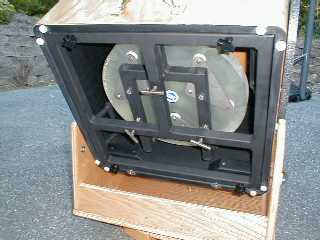 Closeup of the removable mirror cell
Starmaster provides an elasticized black shroud as standard equipment. Numerous
upgrades are available, including a battery-operated secondary heater, wheelbarrow
handles, and a gorgeous Feathertouch focuser (see photo.) Also available is
Starmaster's excellent Sky Commander Goto/tracking system. Along with the
Astro-Physics unit, the Sky Commander is the most accurate, and most trouble-
free Goto system I have ever encountered. It's expensive at nearly $2700,
but if you have the money and must have Goto, you can buy with confidence.
This throws up a superb star test and has an exceptionally smooth figure. We
had trouble detecting any spherical aberration, even at 329X, quite remarkable
for a system operating at f/4.3. The enclosed report states a Strehl ratio of
.988. The telescope is designed to be used with TeleVue's new adjustable
Paracorr. Owners of this model (as well as Rick Singmaster himself) consider
the Paracorr mandatory due to the fast optics. Your reviewer has the minority
opinion - I think the optics are just fine au naturel. I saw some minor coma
near the edges compared to the optics on the ELs I've seen, but it's not serious
by any stretch, and once you get up past 85X or it disappears altogether.
Use your own judgement on this.
Closeup of the removable mirror cell
Starmaster provides an elasticized black shroud as standard equipment. Numerous
upgrades are available, including a battery-operated secondary heater, wheelbarrow
handles, and a gorgeous Feathertouch focuser (see photo.) Also available is
Starmaster's excellent Sky Commander Goto/tracking system. Along with the
Astro-Physics unit, the Sky Commander is the most accurate, and most trouble-
free Goto system I have ever encountered. It's expensive at nearly $2700,
but if you have the money and must have Goto, you can buy with confidence.
This throws up a superb star test and has an exceptionally smooth figure. We
had trouble detecting any spherical aberration, even at 329X, quite remarkable
for a system operating at f/4.3. The enclosed report states a Strehl ratio of
.988. The telescope is designed to be used with TeleVue's new adjustable
Paracorr. Owners of this model (as well as Rick Singmaster himself) consider
the Paracorr mandatory due to the fast optics. Your reviewer has the minority
opinion - I think the optics are just fine au naturel. I saw some minor coma
near the edges compared to the optics on the ELs I've seen, but it's not serious
by any stretch, and once you get up past 85X or it disappears altogether.
Use your own judgement on this.
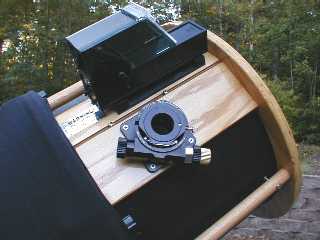 Closeup of the upper truss assembly
and Feathertouch focuser
We set up the 14.5" next to the 11" EL and ran some comparisons. In short, the
14.5" is just like the 11", but more so - more aperture, more resolution, more
things to see, but also more weight and more money. If you already own an EL,
the 14.5" (or the 16", not reviewed yet) is an ideal step up for those wanting to
dip their toe into Big Dob land. Compared to the already superb 11", the 14.5"
resolves globulars to the core more easily, shows more background stars in objects
than you're used to seeing, and opens up more of the deep sky catalog for you.
This telescope is so versatile, Todd Gross makes a case for it being your only
telescope. It has enough aperture to do serious deep sky work. On the other
hand, stop it down with an aperture mask, put it on an equatorial tracking table,
and you've got yourself a makeshift 5" f/12.5 planetary scope. In fact, some of
the best views I have ever gotten on Jupiter were through Todd's stopped-down
14.5" Starmaster.
The downside, as with nearly any premium telescope these days, is its delivery.
The owner of this one was quoted six months. The actual delivery was closer to
an excruciating eleven months. Unfortunately, there is really no way around this.
Carl Zambuto doesn't release any mirror before its time, and Starmaster remains
a small, family-run operation that builds telescopes in relatively small lots (six,
in the case of these 14.5" models.) The serial number of this one is only #50.
Remember, the best things in life are worth waiting for...
It doesn't get much better than this. This is one of my favorite telescopes of any
design and aperture. If you buy one, I suspect you will be very happy with it.
End Telescope Reviews, Page 17
Closeup of the upper truss assembly
and Feathertouch focuser
We set up the 14.5" next to the 11" EL and ran some comparisons. In short, the
14.5" is just like the 11", but more so - more aperture, more resolution, more
things to see, but also more weight and more money. If you already own an EL,
the 14.5" (or the 16", not reviewed yet) is an ideal step up for those wanting to
dip their toe into Big Dob land. Compared to the already superb 11", the 14.5"
resolves globulars to the core more easily, shows more background stars in objects
than you're used to seeing, and opens up more of the deep sky catalog for you.
This telescope is so versatile, Todd Gross makes a case for it being your only
telescope. It has enough aperture to do serious deep sky work. On the other
hand, stop it down with an aperture mask, put it on an equatorial tracking table,
and you've got yourself a makeshift 5" f/12.5 planetary scope. In fact, some of
the best views I have ever gotten on Jupiter were through Todd's stopped-down
14.5" Starmaster.
The downside, as with nearly any premium telescope these days, is its delivery.
The owner of this one was quoted six months. The actual delivery was closer to
an excruciating eleven months. Unfortunately, there is really no way around this.
Carl Zambuto doesn't release any mirror before its time, and Starmaster remains
a small, family-run operation that builds telescopes in relatively small lots (six,
in the case of these 14.5" models.) The serial number of this one is only #50.
Remember, the best things in life are worth waiting for...
It doesn't get much better than this. This is one of my favorite telescopes of any
design and aperture. If you buy one, I suspect you will be very happy with it.
End Telescope Reviews, Page 17
Back to Home Page
 The 12.5" Discovery Dob (TeleVue
Genesis in background) The "Smallest
of the Big Scopes?"
The 12.5" Discovery Dob (TeleVue
Genesis in background) The "Smallest
of the Big Scopes?" Closeup of the Upper Truss Assembly
Note the clean woodworking
Closeup of the Upper Truss Assembly
Note the clean woodworking Closeup on the mirror box
Closeup on the mirror box 20" (L) and 18" (R) Obsessions
6" Dob in front for scale
20" (L) and 18" (R) Obsessions
6" Dob in front for scale A telescope is mostly air - photo
of the mirror cell, with cooling fan
A telescope is mostly air - photo
of the mirror cell, with cooling fan Each Obsession owner gets their name
engraved on a numbered brass plaque
on the mirror box - nice touch
Each Obsession owner gets their name
engraved on a numbered brass plaque
on the mirror box - nice touch Nice scope, Sheriff...
Nice scope, Sheriff... Closeup of the removable mirror cell
Closeup of the removable mirror cell Closeup of the upper truss assembly
and Feathertouch focuser
Closeup of the upper truss assembly
and Feathertouch focuser